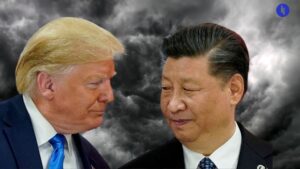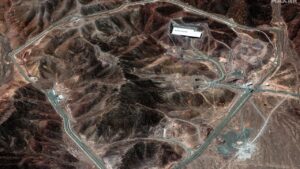Green hydrogen set to double in African by 2023
The Azerbaijan-Armenian conflict kicks off again after 200 people killed in flareup.
Hi there Intriguer. In our piece covering the Swedish election last week, several Intriguers (including an adviser to a Swedish politician!) politely pointed out that we’d made a mistake.
We wrote: “the Sweden Democrats will become the country’s biggest party, overtaking the Social Democrats“. But that’s not correct – the Social Democrats are still the largest party, while the Sweden Democrats are now the second-largest party. But, with their projected 73 MPs, the Sweden Democrats will play a crucial role in what’s expected to be a right-wing governing coalition.
We’re truly lucky to have readers who are world experts in many of the fields we write about, so keep on keeping us honest, Intriguers!
Today’s briefing is a ~4.6 min read:
- ⚡ Green transition: The green hydrogen frontier in Africa.
- ➕ Plus: Renewed fighting between Armenia and Azerbaijan, the US sets up an Afghan relief fund, and South Korea considers bolstering the won.
📰 GLOBAL HEADLINES

Stories: La Tercera, News Ghana, China Daily, Frankfurter Allgemeine, Straits Times
The results from last week’s polls are pretty clear; you love the global headlines!
🟩🟩🟩🟩🟩🟩 😍 Love it (421)
🟨⬜️⬜️⬜️⬜️⬜️ 👎 Replace it with something else (106)
527 Votes
We’ll keep working on innovative visual ways to give you a snapshot of media cycles outside the West, but for now, the headlines aren’t going anywhere! Thanks to those who voted and commented.
🤿 DEEP DIVE
Africa bets big on green hydrogen
In brief:
- Africa’s first green hydrogen plant will be operational by 2024, and several more are expected to follow.
- Africa’s increasing production of green energy will likely give the continent more geopolitical leverage as global demand for energy increases.

A green Namibia
French power producer Hydrogene De France has announced its green hydrogen power plant in Namibia will start producing electricity by 2024.
- Once operational, it’ll be the first green hydrogen plant on the African continent.
It won’t be the last – this past May, Egypt, Kenya, Mauritania, Morocco, Namibia, and South Africa launched the Africa Green Hydrogen Alliance (AGHA) to promote more of these projects across the continent.
But what exactly is ‘green hydrogen’? (A fair question, given that hydrogen is colourless)
- Hydrogen can only be labelled ‘green’ if it’s extracted from water through a process powered by renewable energy sources, such as solar power.
- Once distilled, hydrogen can be used as a fuel (like how we currently use natural gas), with the bonus that its combustion produces water rather than carbon dioxide.
The pros and cons
Overall, green hydrogen is an attractive energy source for Africa for several reasons:
- 🏪 Convenience: Turning renewable power into liquid hydrogen allows you to conserve the fuel for use on days when the sun isn’t shining or the wind isn’t blowing.
- ☀️ Sun: Africa receives more hours of sunshine each year than any other continent, giving it an advantage over depressing less sunny regions.
- 🐂 Companies are bullish on ‘green’ initiatives: For example, Egypt received pledges to invest $42B to build green ammonia and green hydrogen plants, in part thanks to Europe’s need to replace Russia as an energy provider.
But green hydrogen has its drawbacks:
- 💰 It’s expensive: producing one kilogram of hydrogen via renewable energy costs several times more than producing it through other methods.
- 🏗 It requires specific infrastructure: storing and transporting hydrogen can be difficult and requires a network of purpose-built pipelines.
More geopolitical leverage for Africa
Currently, only ~9% of all energy produced in Africa is generated through renewable sources, but that figure is set to double in the next few years.
That increase could give African countries more leverage in global politics, especially as the dates for those climate pledges inch closer and countries need to transition their economies to green energy sources.
As analysts Bitsat Yohannes and Arona Diedou put it:
“There is, indeed, a global race to develop green hydrogen, and for the first time, Africa is on the starting line with developed countries.”
Sponsored by Trends
Your next business idea, delivered weekly.
Trends tells you the next big thing – months before everyone else. Their dynamic team of business analysts already outlined 1,000+ vetted business ideas you can start in a weekend, and they send new ideas and market signals straight to your inbox weekly.
🔦 REGIONAL SPOTLIGHT
North & Central Asia
🇦🇫 Afghanistan
The US recently established a $3.5B fund to help the Afghan people, using funds from Afghanistan’s central bank that were frozen after the Taliban takeover.
- The ‘Afghan Fund’ is based in Switzerland and reportedly has robust safeguards to prevent the fund from being used for nefarious activity (i.e. by the Taliban).
- The Taliban has insisted that the full amount must be returned *to them* if Afghanistan is to weather the current economic crisis.
🇨🇳 China
Go east! Russian Energy Minister Alexander Novak announced last week that the Nord Stream 2 pipeline will be replaced by an alternative eastward gas pipeline to China.
- Novak also flagged a potential future gas procurement agreement with China worth 50 billion cubic metres of gas per year.
- In the first half of 2022, Chinese imports of Russian gas increased by ~30% compared to the previous year, owing to low prices and deepening China-Russia energy ties.
🇯🇵 Japan
Japan is reportedly considering issuing a special government bond to increase defence spending.
- In August, the Ministry of Defence asked for a budget of over $40B for the 2023 fiscal year – its largest ever request.
- Japan has increasingly pivoted away from its post-WWII pacifist line, with Prime Minister Fumio Kishida pledging to “fundamentally reinforce Japan’s defence capabilities” during his tenure.
🇰🇬 Kyrgyzstan
Kyrgyzstan and Tajikistan have agreed to a ceasefire after fighting broke out along a contested area between the two countries.
- Russia, a close ally to both countries, likely had a part in securing the ceasefire during last week’s Shanghai Cooperation Organization meeting.
- Border skirmishes between Kyrgyzstan and Tajikistan are not uncommon, but they regularly escalate and have become a significant source of instability in Central Asia.
🇰🇷 South Korea
South Korean Finance Minister Choo Kyung-ho plans to review the country’s foreign exchange “contingency plans” after the won tumbled to 13-year lows against the US dollar.
- A weak won will increase inflation concerns because South Korea imports over 90% of its energy and natural resources.
- Choo attempted to calm the foreign exchange market by promising to intervene to tackle excessive volatility, although no specific measures were mentioned.
🗞 IN OTHER NEWS…

More fighting along the Armenia-Azerbaijan border
The news: More than 200 people have died after fighting erupted between Armenian and Azerbaijan forces. Last week’s clashes were the deadliest in about two years.
- Each country accused the other of starting the fighting, but reports suggest that villages along the Armenian side of the border sustained the most damage.
- Thankfully, a ceasefire has been agreed upon and seems to be holding up (for now).
A historic conflict: Armenia and Azerbaijan are locked in a dispute over Nagorno-Karabakh, a region internationally recognised as Azerbaijani territory but inhabited and governed by ethnic Armenians.
- In 2020, a six-week war was ended by a Russian-negotiated ceasefire, but the tensions never really subsided.
A proxy conflict: The Nagorno-Karabakh dispute is complicated by the fact that Turkey supports Azerbaijan and Russia backs Armenia, and the two regional powers are struggling for influence in the Caucasus.
- Some analysts have suggested that Russia’s perceived weakness in Ukraine has emboldened Azerbaijan.
- To add to the complexity, the EU signed an agreement in July to more than double its Azerbaijani gas imports by 2027, meaning the EU will likely take a more active interest in the conflict.
The Pelosi wildcard: Fresh off not getting killed during her visit to Taiwan, US Speaker of the House Nancy Pelosi popped in on Armenian Prime Minister Nikol Pashinyan in Yerevan over the weekend to convey “the strong and ongoing support of the United States for Armenia“.
- She is the highest-ranking US official to visit Armenia since it became independent after the dissolution of the USSR.









